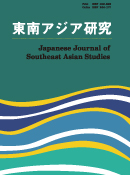Volume 52, Issue 2
Displaying 1-17 of 17 articles from this issue
- |<
- <
- 1
- >
- >|
Articles
-
2015 Volume 52 Issue 2 Pages 137-171
Published: January 31, 2015
Released on J-STAGE: October 31, 2017
Download PDF (1701K) -
2015 Volume 52 Issue 2 Pages 172-207
Published: January 31, 2015
Released on J-STAGE: October 31, 2017
Download PDF (1730K) -
2015 Volume 52 Issue 2 Pages 208-234
Published: January 31, 2015
Released on J-STAGE: October 31, 2017
Download PDF (1086K) -
2015 Volume 52 Issue 2 Pages 235-266
Published: January 31, 2015
Released on J-STAGE: October 31, 2017
Download PDF (1153K) -
2015 Volume 52 Issue 2 Pages 267-294
Published: January 31, 2015
Released on J-STAGE: October 31, 2017
Download PDF (1134K) -
2015 Volume 52 Issue 2 Pages 295-322
Published: January 31, 2015
Released on J-STAGE: October 31, 2017
Download PDF (1092K)
Book Reviews
-
2015 Volume 52 Issue 2 Pages 323-325
Published: January 31, 2015
Released on J-STAGE: October 31, 2017
Download PDF (930K) -
2015 Volume 52 Issue 2 Pages 325-327
Published: January 31, 2015
Released on J-STAGE: October 31, 2017
Download PDF (931K) -
2015 Volume 52 Issue 2 Pages 328-330
Published: January 31, 2015
Released on J-STAGE: October 31, 2017
Download PDF (980K) -
2015 Volume 52 Issue 2 Pages 330-333
Published: January 31, 2015
Released on J-STAGE: October 31, 2017
Download PDF (985K) -
2015 Volume 52 Issue 2 Pages 333-335
Published: January 31, 2015
Released on J-STAGE: October 31, 2017
Download PDF (995K) -
2015 Volume 52 Issue 2 Pages 335-338
Published: January 31, 2015
Released on J-STAGE: October 31, 2017
Download PDF (1006K) -
2015 Volume 52 Issue 2 Pages 338-340
Published: January 31, 2015
Released on J-STAGE: October 31, 2017
Download PDF (981K) -
Nishimura Masaya. Archaeology and Ancient History of Vietnam. Tokyo: Doseisha Co., Ltd., 2011, 360p.2015 Volume 52 Issue 2 Pages 340-343
Published: January 31, 2015
Released on J-STAGE: October 31, 2017
Download PDF (1010K) -
2015 Volume 52 Issue 2 Pages 343-346
Published: January 31, 2015
Released on J-STAGE: October 31, 2017
Download PDF (1008K) -
2015 Volume 52 Issue 2 Pages 346-348
Published: January 31, 2015
Released on J-STAGE: October 31, 2017
Download PDF (1000K) -
2015 Volume 52 Issue 2 Pages 348-350
Published: January 31, 2015
Released on J-STAGE: October 31, 2017
Download PDF (999K)
- |<
- <
- 1
- >
- >|
